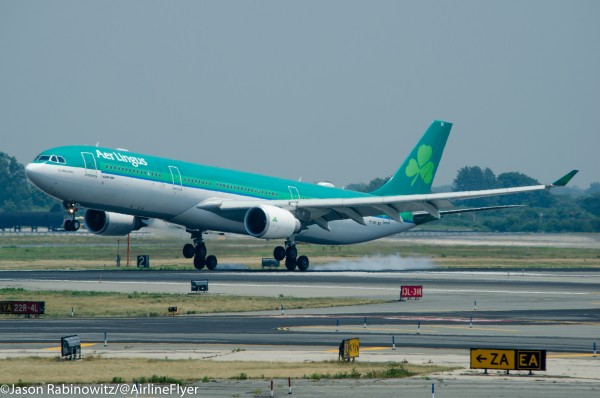
Used with permission from @Airlineflyer; Source URL
Like any good Irishman (I do have a bit in me, after all), I took St. Patrick’s Day off work. Except I didn’t head down to Murphy’s or O’Toole’s pub, I headed to downtown Washington, D.C., to attend the US Chamber of Commerce’s Aviation Summit 2015. It was well worth a day out of the office. You can find some great tweets about it by searching #Aviation15 (you might even see some of mine too!)
By the numbers:
- ~50 speakers, panelists, and introducers (if that’s a word)
- 7 Panels
- 27 Current or former CEO’s
A little more by the numbers – 4 central themes:
- US3 (United, Delta, American) vs. ME3 (Etihad, Emirates, Qatar)
- The US needs transformative air traffic control
- Airlines and Airports don’t agree on Airport funding (e.g. Passenger Facility Charges)
- Low Cost Carriers (LCCs) provide for interesting conversation.
Now some meat (or, if you will, corned beef and cabbage):
US3 v ME3
The beginning keynote was by Carsten Spohr, Chairman and CEO of Lufthansa Group, and while Mr. Spohr was quick to highlight Lufthansa’s 60 year anniversary of restarting, since World War II, he quickly took on the issue of that the US3 have been pushing against the ME3. Spohr highlighted Lufthansa’s Joint Venture with United, totaling to 280 flights, and noted that 2008 balanced US-German open skies service, but not necessarily investment. He stated that Lufthansa is working toward being the first European-based, private 5-star airline. This is meaningful considering Qatar Airways advertises heavily that they are the first 5-star airline. Spohr finished with a phrase that I’d hear multiple times in various forms throughout the day: “We can compete with any company, but cannot compete with a [nation]-state.”
Soon after, James Hogan, Etihad Airways had the stage, and he highlighted 10 key facts about Etihad. I don’t have his speech, so I don’t want to mistake the numbering, but he highlighted:
- The ME3 have 3 Different business models
- Etihad’s fiercest competitor is Emirates
- Emirates carries 3 times the passengers of Etihad, yet the 3 legacy carriers of the EU carry 18 times more passengers.
- Etihad is always a new entrant to markets–e.g. not creating markets.
- Etihad (and really all of the ME3) are helped by their geographic location.
- Etihad offers “incredible customer service”
- Etihad values partnering — Hogan stated that Etihad has 49 partnerships.
- Etihad is focused on cost, in fact, Hogan noted that the airline reached breakeven under 10 years.
- Etihad will have the largest 787 dreamliner fleet (71 aircraft).
- Etihad fills the equivalent of 3 737-800s with connecting passengers on the US3 per day in the US.
Hogan’s parting words: “We shouldn’t attack what we don’t understand.” – It is difficult for me to understand what to make of that, considering, to an extent, he attacked the US3’s report, without ever having the chance to read it. Hogan did sit on a panel after his speech, where there were some more diplomatic statements, including by Bill Flynn, Atlas Air CEO. Personally, I thought Flynn was one of the best speakers of the day, highlighting the value of 5th and 7th freedom, and really avoiding the US3 v ME3 controversy.
There were a handful of comments throughout the day, keynoted by Doug Parker (CEO of American), at the end of the day.
Transformative Air Traffic Control for the US
Congressman Bill Shuster, Chairman of the House Transportation and Infrastructure committee started the discussion about transformative Air Traffic Control for the US, and that conversation continued through a number of panels. The comment, that the US has spent $6B on NexGen and airlines state that they haven’t seen any value, came up multiple times. That $6B is 3 times what was originally planned. Bob Crandall, former CEO of American Airlines chaired a panel with a mix of folks, including John W. Chrichton, CEO of NAV CANADA, a non-profit that runs Canada’s Air Traffic Control System, and Ed Bolen, CEO of National Business Aviation Association. The panel, unfortunately, focused mostly on fears of business travel being locked out of key airports under a new system. Jeff Smisek, United CEO was on the panel as well, but he only had a couple of what sounded like canned statements, and a couple of questions for the ATC organization CEOs.
Airport Funding
There was a panel on FAA Reauthorization, moderated by Alexandre de Gunten, Business Development Officer for HEICO Aerospace. I won’t say I was familiar with Alexandre, nor his company, but the panelists: Stephan A. Alterman, President of the Cargo Airline Association, Kevin Burke, President and CEO of Airports Council International – North American, The Honorable James H. Burnley IV, former US Secretary of Transportation, and Sharon Pinkerton, Senior VP for Legislative and Regulatory Policy for Airlines for America, really made this an interesting, but repetitive panel to hear.
The panel really ended up focusing most on Burke and Pinkerton going back and forth on proposed Passenger Facility Charge (PFC) increases. Many numbers were thrown own, and occasionally, the two would turn to Burnley as the voice of reason. The fact remains, that Airlines don’t want more PFC increases, because it increases their fare costs–with no value to the airlines–and Airports want more funding, and will take it any way they can get it.
Low Cost Carriers
Perhaps my most favorite panel of the day, was a CEO Panel with David Cush, CEO of Virgin America, Maurice J. Gallagher Jr., CEO of Allegiant Air, Robin Hayes, CEO of JetBlue, and David N. Siegel, CEO of Frontier. It was chaired by T. Allan McArtor, CEO of Airbus Group, Inc. First off, I have to say, McArtor did an excellent job of moderating, not slipping in Airbus at all, and he guided the conversation to really interesting topics. Each panelist took a few moments to speak about their company.
- Siegel highlighted that when he had taken over Frontier, 95% of capacity was in Denver. Now, Frontier has redeployed half of that capacity.
- Siegel also highlighted that the biggest issue for Low Cost Carriers (LCCs), was access to airports. All of the other CEOs echoed this as a huge issue, that in many takes government intervention to resolve (e.g. DCA slots being opened up by the US-AA merger).
- Hayes highlighed that JetBlue’s model remains to be a Customer First model. He also highlighted that JetBlue embraces OpenSkies, noting that International Partners help JetBlue to expand and lower fares (such as lowering fares ex-Boston by ~30%).
- Cush, echoing Siegel’s comment, stated that airlines really fight a real estate game (gates and slots), and that Virgin America only got into DCA because of the US-AA merger.
- Siegel’s best quote of the day though, in my opinion was: “you can be a low fare carrier in 5 minutes, just change your fares, but it takes a lifetime to be a low cost carrier.”
- One of the other points made by the panelists was that lower fuel price isn’t going to result in lower fares. What lower fuel prices can (and do) result in, is increased frequency and routes.
- Siegel stated for example that he couldn’t cut fares by $20, because he would not have the capacity to meet the demand. Airlines are flying at 90% load factors, meaning there wouldn’t be enough seats to sell at the lower price.
- Cush followed this point up saying that given temporarily lower fuel costs, capacity increases are the result of delaying aircraft retirement, more than adding additional aircraft. In fact, in the investor panel, one of the speakers stated that airlines don’t plan their 20 year fleet plans on 6 months of lower fuel costs.
- On In Flight Entertainment (IFE), Siegel noted that Frontier will be removing their outdated IFE (and not replacing it). That plus slimline seats will equate to 3,000 (thanks Seth!) pound lighter aircraft (I didn’t hear which, sorry!).
- Cush of Virgin America took a different view, noting that when you’re home, you likely have your tablet or laptop open, as you’re watching TV. Virgin America is trying to mimic that experience on the plane.
Wrapping Up
Overall, attending the US Chamber of Commerce Aviation Summit 2015 was very informative. I enjoyed taking a day off and chatting with folks in the industry, and hearing the legions of CEOs speak. Perhaps even more humorous, was when I ducked out during one of the breaks to check out the Etihad Apartment display and I saw two crew members from my most recent flight on Etihad’s A380 (post forthcoming).
Because no post about a fun conference event is complete without a give-away, we have one! To enter, all you have to do is leave a comment (even if only to say hi!) with which of the 4 themes I identified in the post, that resonates most with you. Then we will choose a lucky winner to get a wonderful Lufthansa Duck and duffle bag! Please comment no later than 5pm Thursday 26 March, and we’ll choose a winner.

Removing the IFE & changing out seats should save 3000 pounds of weight, I’d bet. Between the screens, wiring and control boxes it all adds up. Plus the new seats alone are often 10-15 pounds lighter than the old ones.
That is offset a bit by installing more of them, but the result remains.
@Wandering Aramean – Thanks for the clarification! I figured it had to be more than 300lbs, but wasn’t certain.
Ducky! Ducky!
I mean ‘hi!’ 🙂
(Pick me!)